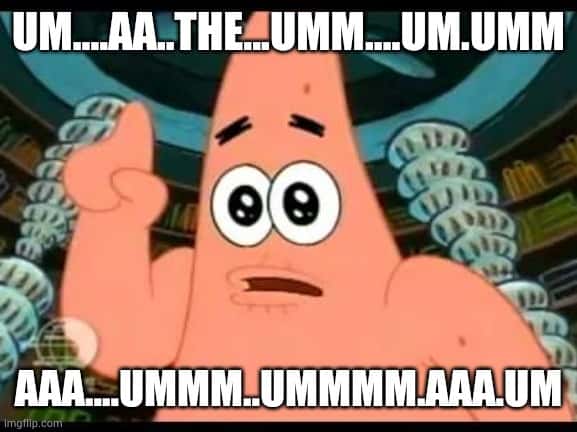6-10% of language is made up of ‘ums’ and ‘ers’

Did you know that disfluencies make up approximately 6 to 10 percent of spontaneous speech across languages? (Clark & Fox Tree, 2002). But have you ever paused to ponder the purpose behind those familiar “ums” and “ers” that slip into our conversations?
Why do we um? Planning a sentence, holding attention or just fitting in
Studies show in brain scans when we ‘um’ and ‘er’ different parts of our brain light up that are responsible for speech production and monitoring. Neuroscientific studies using fMRI and EEG have shown different neural activation patterns during the production and perception of disfluencies (ums and ers). These interruptions show that we ‘um’ and ‘er’ when a speaker has difficulty planning an utterance, in terms of timing and organising the flow of words.
The use of speech fillers can also be used to hold the speech floor, (people are waiting attentively to the speaker’s next utterance). ‘
Certain social groups have their own disfluencies that members adopt in order to fit in in reciprocal social interaction.
Ums’ and ‘ers’ can also be used to convey uncertainty, this is why politicians try to avoid using them.
Ums and ers in other languages
While “um” and “uh” are common disfluencies in English, other languages have their own unique equivalents. For instance, Swedish speakers often use “äh” or “öh,” while Russian speakers rely on “э-э” or “это” (Levinson, 2013).
In French, speakers commonly use “euh” or “em” as vocal pauses, while Spanish speakers employ “eh” and “pues.” Japanese speakers often rely on “etto” and “ano” to fill conversational gaps. These cultural nuances reflect the diversity and richness of global language usage.
Young people ‘erm’ more than old people
Research suggests that the use of disfluencies varies depending on factors such as age, gender, and social context. For instance, studies have shown that younger speakers tend to use more disfluencies than older individuals (Smith, 2007).

Animals also um
Disfluencies are not limited to human speech. Studies have demonstrated that chimpanzees, dolphins, and birds also exhibit similar interruptions in their vocalizations (Berwick et al., 2017).
Disfluencies, or vocal interruptions, are not limited to human communication. Research has shown that various animal species, including primates, dolphins, and birds, also exhibit similar patterns of interruptions in their vocalizations.
- Primates:
Primates, particularly chimpanzees and bonobos, have been observed to produce vocal interruptions analogous to human disfluencies. These interruptions, characterized by hesitations, repetitions, and non-lexical sounds, serve similar functions to human disfluencies, such as signaling uncertainty or hesitation during communication (Berwick et al., 2017). Studying disfluencies in primates provides valuable insights into the evolutionary origins of vocal interruptions and their role in social interaction. - Dolphins:
Dolphins are known for their complex vocalizations and communicative abilities. Studies have documented instances of disfluencies in dolphin vocalizations, including repetitions, pauses, and variations in pitch and rhythm. These interruptions are thought to play a role in the coordination of social interactions, facilitating turn-taking and conveying information (King et al., 2013). - Birds:
Some avian species, such as songbirds, also exhibit vocal interruptions akin to disfluencies. These interruptions manifest as hesitations, repetitions, or unexpected pauses in their complex vocal repertoire. Research suggests that these interruptions may serve purposes such as maintaining the integrity of song structure, facilitating learning, or signalling changes in motivation or attention (Kao et al., 2019).
Disfluencies in Sign Language
Disfluencies are not exclusive to spoken languages; they also occur in sign languages. Instead of vocal interruptions, sign languages have their own visual equivalents, such as pauses, repetitions, or movements indicating hesitation. This highlights the importance of disfluencies in all forms of human language expression.
People who ‘um’ are perceived as more honest
Surprisingly, research suggests that the presence of disfluencies in speech can be linked to perceptions of honesty. Studies have shown that individuals who incorporate more disfluencies in their spontaneous speech are often perceived as more genuine and trustworthy by their listeners. This perception may be due to the belief that disfluencies reflect spontaneous and unfiltered thoughts.
How much do we ‘um’?
We speak 150wpm (average typing speed is 40wpm) and the average person has 6 disfluencies per 100 words, so for one minute of speech a normal person would use nine filler words. That’s why Radio 4’s Just a Minute is so hard! By speaking more slowly and using thoughtful silences instead of disfluencies like um and er you can eliminate disfluencies. Former President Barack Obama spoke with hardly any disfluencies.

Sources:
ABC News – Psychologists Say ‘Um’ and ‘Uh’ Have Meaning
Like, Um, How Do I Stop, Ya Know, Using Um and Ah? Toastmasters International






